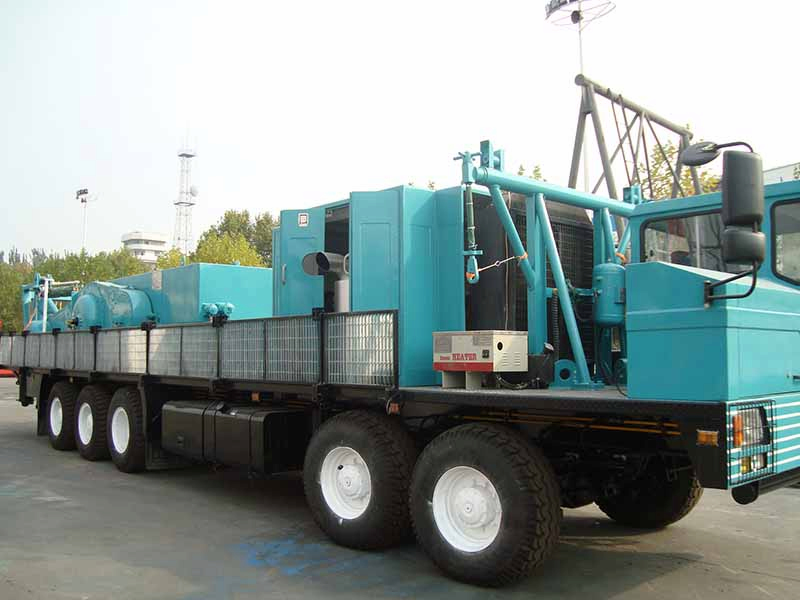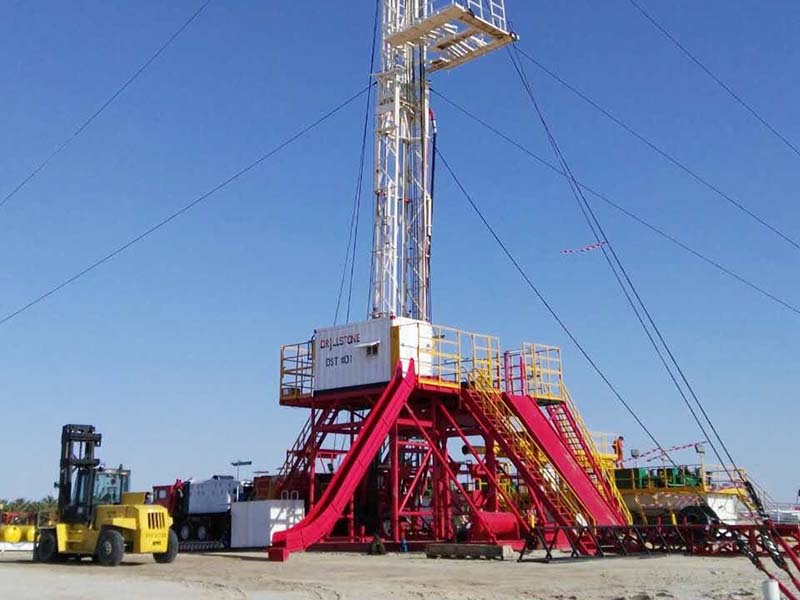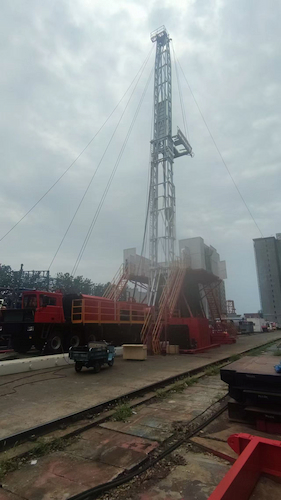ما هي الأنظمة الثمانية الرئيسية لجهاز الحفر؟
Sep 18, 2025
منصة حفر النفط هي معدة ميكانيكية واسعة النطاق تُستخدم في عمليات حفر النفط والغاز. وظيفتها الرئيسية هي تشغيل أدوات الحفر لتكسير الصخور الجوفية وحفر آبار النفط، مما يوفر قنوات للاستغلال اللاحق، وبالتالي تحقيق استكشاف وتطوير موارد النفط والغاز. تشمل وظائفها الأساسية رفع وخفض أدوات الحفر، والحفر الدوراني، وتنظيف الآبار بالتدوير. تتكون بشكل رئيسي من آلات الطاقة، وآليات النقل، وآلات التشغيل، والمعدات المساعدة. يمكن تصنيفها، حسب سيناريوهات التشغيل، إلى منصات حفر نفط برية وأخرى بحرية، وهي بنية تحتية أساسية لضمان إمدادات النفط والغاز العالمية.أنظمة المكونات الأساسيةA منصة الحفر يتكون من ثمانية أنظمة رئيسية: يتحكم نظام الرفع في رفع وخفض أدوات الحفر عبر أعمال الرسم وكتل البكرات؛ ويحرك النظام الدوار مِثقاب الحفر لكسر التكوينات الصخرية؛ ويستخدم نظام الدورة الطين عالي الضغط لإزالة القطع؛ ويوفر نظام الطاقة والنقل توزيع الطاقة؛ وينسق نظام التحكم تشغيل المعدات؛ ويوفر البرج والهيكل الأساسي الدعم؛ وتتضمن المعدات المساعدة أجهزة السلامة مثل مانع الانفجار(BOP). المكونات الأساسية تشمل برج الحفر, كتلة التاج, طاولة دوارة، وأنواع مختلفة من رؤوس الحفر. محرك علوي تعتمد منصات الحفر على تقنية الدفع العلوي (الدوران الكهربائي)، مما يُحسّن كفاءة الحفر ويُناسب عمليات الآبار العميقة. أثناء التشغيل، تُدوّر مضخات الطين الطين لتبريد لقمة الحفر، وتُضبط آليات الكبح معايير الحفر.1. نظام الرفعنظام الرفع مُجهّز لرفع وخفض أدوات الحفر، وتشغيل الغلاف، والتحكم في وزن المثقاب (WOB)، وتغذية أدوات الحفر. ويشمل آليات السحب، والفرامل المساعدة، كتلة التاج, كتلة السفر, خطاف, حبل سلكي، وأدوات مختلفة مثل وصلة المصعدس, المصاعد، ملقط، وزلاقات.عند الرفع، تُلف أسطوانة الجرّ الحبل السلكي؛ وتُشكّل كتلة التاج وكتلة الحركة نظام بكرة ثانوي. يرتفع الخطاف لرفع أدوات الحفر عبر أدوات مثل وصلات الرفع والمصاعد. عند الإنزال، تنزل أدوات الحفر أو سلك التغليف بوزنها، ويتم التحكم في سرعة إنزال الخطاف بواسطة آلية كبح الجرّ والمكابح المساعدة. أثناء الحفر العادي، يتم التحكم في سرعة تغذية أدوات الحفر بواسطة آلية الكبح، ويُطبّق جزء من وزن أداة الحفر على لقمة الحفر كـ WOB لكسر التكوينات الصخرية.2. النظام الدوارالنظام الدوار هو نظام نموذجي لمنصة الحفر الدوارة، ويتمثل دوره في تحريك أدوات الحفر لتدويرها لتكسير التكوينات الصخرية. ويشمل الطاولة الدوارة، والمحور، و أداة الحفريختلف تركيب أدوات الحفر حسب نوع البئر المراد حفرها؛ فهو يشمل عمومًا الكيلي، أنبوب الحفر, طوق الحفرs، ومثقاب الحفر، بالإضافة إلى المثبتات، وامتصاص الصدمات، ومحولات الصوت الفرعية.من بينها، لقمة الحفر هي الأداة التي تُكسر الصخور مباشرةً. تتميز أطواق الحفر بوزنها وسمك جدارها العاليين، وتُستخدم لتطبيق WOB على لقمة الحفر. تربط أنابيب الحفر المعدات السطحية بمعدات قاع البئر وتنقل عزم الدوران. عادةً ما يكون للكيلي مقطع عرضي مربع؛ وتُحرك الطاولة الدوارة سلسلة الحفر بأكملها ولقمة الحفر للدوران عبر الكيلي. يُعدّ المفصل الدوار مكونًا أساسيًا في منصة الحفر الدوارة: فهو لا يتحمل وزن أدوات الحفر فحسب، بل يُمكّن أيضًا من الحركة الدورانية، مع توفير قناة للطين عالي الضغط.Ⅲ. نظام الدورة الدمويةتم تجهيز منصة الحفر الدوارة بنظام دوران لنقل القطع المكسورة بواسطة مثقب الحفر إلى السطح على الفور من أجل الحفر المستمر، مع تبريد مثقب الحفر وحماية بئر الحفر ومنع حوادث الحفر مثل انهيار البئر وفقدان الدورة.يتضمن نظام التداول مضخة الطينمشعبات سطحية، وخزانات طينية، ومعدات تنقية الطين. تشمل مشعبات السطح مشعبات ضغط عالي، وأنابيب عمودية، وخطوط خراطيم؛ وتشمل معدات تنقية الطين هزاز الصخر الزيتيس, مزيلات الرمل، مزيلات الطمي، و أجهزة الطرد المركزي لطين الحفر.تقوم مضخة الطين بسحب الطين من خزان الطين؛ وبعد ضغطه، يتدفق الطين عبر مشعب الضغط العالي، وأنبوب الوقوف، وخط الخرطوم، ويدخل إلى المحور الدوار، ويُخفض إلى قاع البئر عبر أدوات الحفر المجوفة. يُطرد الطين من فوهات لقمة الحفر، ثم يحمل بقايا الحفر إلى السطح عبر الفراغ الحلقي بين جوف البئر وأدوات الحفر. يمر الطين العائد من قاع البئر عبر مستويات مختلفة من معدات تنقية الطين لإزالة المواد الصلبة، ثم يُعاد استخدامه.4. معدات الطاقةنظام الرفع، ونظام الدوران، ونظام الدوران هي وحدات العمل الرئيسية الثلاث في منصة الحفر، وتُستخدم لتوفير الطاقة. يُمكّن تشغيلها المنسق من إتمام عمليات الحفر. لتزويد هذه الوحدات بالطاقة، يجب أن تكون منصة الحفر مُجهزة بمعدات طاقة. تشمل معدات الطاقة في منصة الحفر محركات الديزل، ومحركات التيار المتردد، ومحركات التيار المستمر.Ⅴ. نظام النقليقوم نظام النقل بتحويل القوة والحركة الناتجة عن معدات الطاقة، ثم ينقلها ويوزعها على كل وحدة عاملة لتلبية احتياجاتها المختلفة من الطاقة. يتضمن نظام النقل عمومًا آلية تخفيض، وآلية تغيير السرعة، وآلية توجيه/عكس، وآلية ربط بين عدة آلات طاقة.Ⅵ. نظام التحكملضمان التشغيل المنسق لوحدات العمل الرئيسية الثلاث في منصة الحفر وتلبية متطلبات تقنية الحفر، زُوِّدت منصة الحفر بنظام تحكم. تشمل أساليب التحكم التحكم الميكانيكي، والتحكم الهوائي، والتحكم الكهربائي، والتحكم الهيدروليكي.طريقة التحكم الشائعة في منصات الحفر هي التحكم الهوائي المركزي. يستطيع الحفار إتمام جميع عمليات التحكم تقريبًا في منصة الحفر من خلال لوحة التحكم الخاصة به، مثل تشغيل/فصل القابض الرئيسي؛ وربط عدة آلات طاقة؛ وتشغيل/إيقاف وحدات السحب، والطاولة الدوارة، ومضخات الطين؛ والتحكم في سرعة وحدات السحب.Ⅶ. برج الحفر والبنية التحتيةيُستخدم برج الحفر والهيكل الأساسي لدعم وتركيب معدات وأدوات الحفر المختلفة، وتوفير موقع لعمليات الحفر. يُستخدم برج الحفر لتركيب كتلة التاج، وتعليق كتلة الحركة، والخطاف، والمحور، وأدوات الحفر، وتحمل أحمال الحفر، وحاملات المكدس. يُستخدم الهيكل الأساسي لتركيب وحدة الطاقة، ووحدة السحب، والطاولة الدوارة، ودعم برج الحفر، وتعليق أدوات الحفر عبر الطاولة الدوارة، وتوفير مساحة ارتفاع بين الطاولة الدوارة والأرض لتركيب مانعات التسرب اللازمة وتسهيل دوران الطين.Ⅷ. المعدات المساعدةولضمان السلامة والتقدم الطبيعي للحفر، تتضمن منصة الحفر أيضًا معدات مساعدة أخرى، مثل ميزان المدفوعات مدخنة لمنع الانفجارات، ومجموعة مولدات لتوفير الإضاءة والطاقة المساعدة للحفر، وجهاز ضغط الهواء لتزويد الهواء المضغوط، ومعدات إمداد المياه وإمدادات النفط.
اقرأ أكثر


